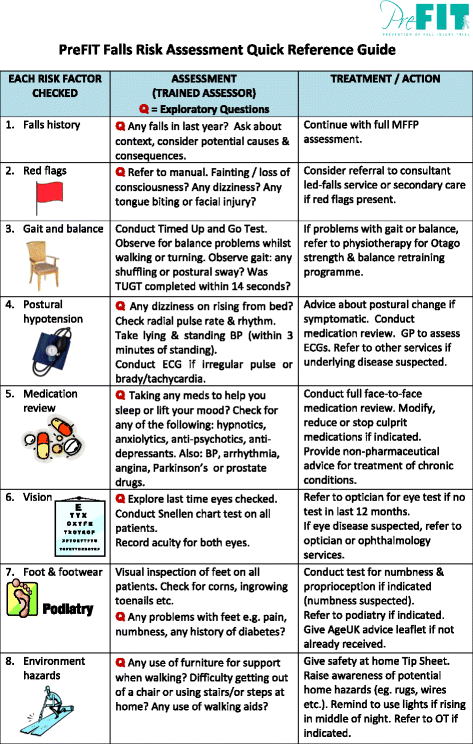Some Known Details About Dementia Fall Risk
Dementia Fall Risk Things To Know Before You Get This
Table of ContentsDementia Fall Risk for BeginnersDementia Fall Risk - The FactsThe Basic Principles Of Dementia Fall Risk Some Known Questions About Dementia Fall Risk.
A fall danger assessment checks to see how most likely it is that you will fall. The analysis usually consists of: This consists of a collection of questions concerning your total health and wellness and if you have actually had previous falls or issues with balance, standing, and/or walking.Interventions are recommendations that may lower your threat of dropping. STEADI consists of 3 steps: you for your threat of dropping for your danger elements that can be boosted to attempt to prevent falls (for example, balance issues, impaired vision) to lower your danger of dropping by making use of reliable methods (for instance, offering education and learning and sources), you may be asked a number of questions including: Have you dropped in the past year? Are you worried regarding dropping?
If it takes you 12 secs or more, it might imply you are at greater danger for a fall. This test checks toughness and equilibrium.
The positions will certainly get more challenging as you go. Stand with your feet side-by-side. Relocate one foot midway forward, so the instep is touching the big toe of your various other foot. Move one foot fully in front of the other, so the toes are touching the heel of your various other foot.
The smart Trick of Dementia Fall Risk That Nobody is Discussing
Many drops occur as a result of several contributing aspects; consequently, taking care of the threat of falling begins with identifying the elements that contribute to drop threat - Dementia Fall Risk. Some of one of the most relevant threat elements consist of: Background of previous fallsChronic medical conditionsAcute illnessImpaired gait and balance, reduced extremity weaknessCognitive impairmentChanges in visionCertain high-risk medications and polypharmacyEnvironmental elements can additionally increase the risk for drops, consisting of: Inadequate lightingUneven or harmed flooringWet or unsafe floorsMissing or damaged handrails and grab barsDamaged or incorrectly fitted tools, such as beds, wheelchairs, or walkersImproper use of assistive devicesInadequate supervision of individuals living in the NF, including those that display hostile behaviorsA successful fall threat administration program calls for a thorough clinical assessment, with input from all participants of the interdisciplinary group

The treatment strategy must additionally include treatments that are system-based, such as those that advertise a secure setting (appropriate lights, hand rails, get hold of bars, and so on). The efficiency of the interventions his explanation ought to be evaluated occasionally, and the treatment strategy modified as needed to mirror modifications in the fall threat assessment. Applying an autumn risk monitoring system making use of evidence-based best practice can reduce the prevalence of falls in the NF, while restricting the potential for fall-related injuries.
An Unbiased View of Dementia Fall Risk
The AGS/BGS guideline advises evaluating all adults aged 65 years and older for autumn danger annually. This testing contains asking people whether they have actually dropped 2 or more times in the previous year or sought medical focus for a fall, or, if they have not dropped, whether they really feel unsteady when walking.
People that have dropped once without injury needs to have their balance and stride examined; those with gait or balance abnormalities must obtain added analysis. A history of 1 fall without injury and without gait or equilibrium issues does not warrant more assessment past ongoing Going Here yearly autumn threat screening. Dementia Fall Risk. A loss danger assessment is required as part of the Welcome to Medicare assessment

The Facts About Dementia Fall Risk Revealed
Recording a falls background is just one of the high quality indicators for fall prevention and monitoring. A crucial part of danger assessment is a medication review. Several courses of drugs enhance loss risk (Table 2). content Psychoactive medications in certain are independent forecasters of falls. These medications tend to be sedating, change the sensorium, and hinder balance and gait.
Postural hypotension can commonly be relieved by reducing the dose of blood pressurelowering drugs and/or stopping medicines that have orthostatic hypotension as an adverse effects. Use above-the-knee support tube and resting with the head of the bed boosted might additionally decrease postural decreases in blood pressure. The preferred aspects of a fall-focused physical exam are received Box 1.

A Pull time greater than or equivalent to 12 secs recommends high autumn danger. Being incapable to stand up from a chair of knee height without utilizing one's arms shows enhanced loss threat.